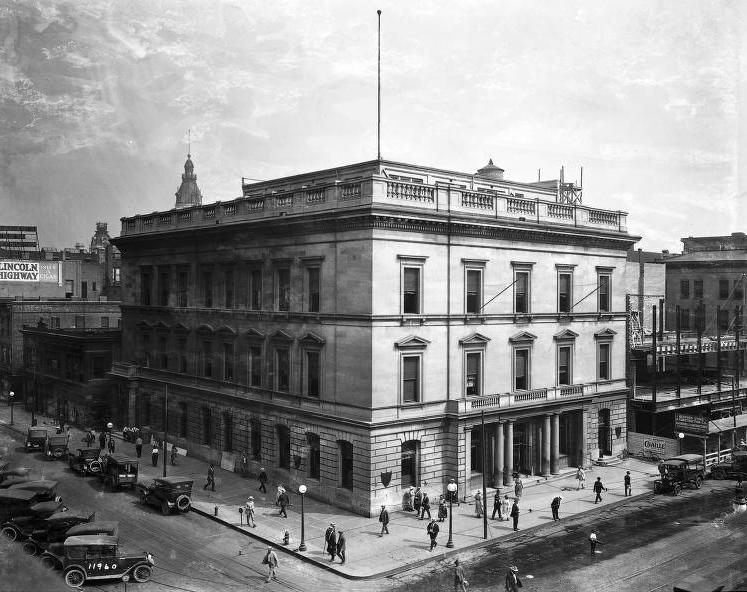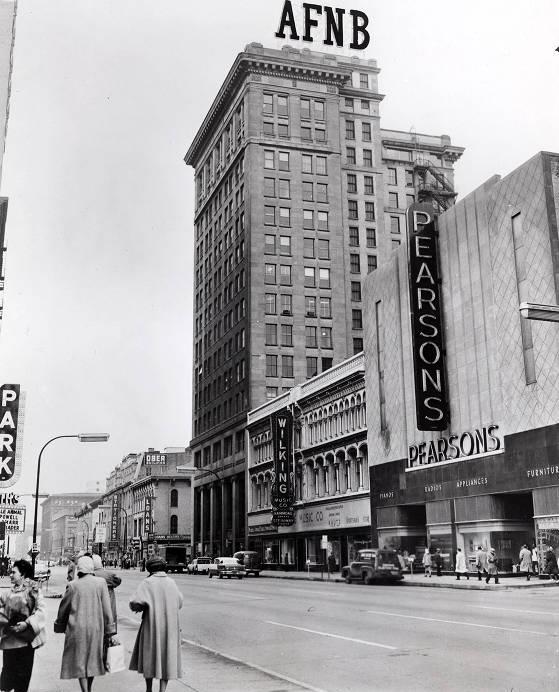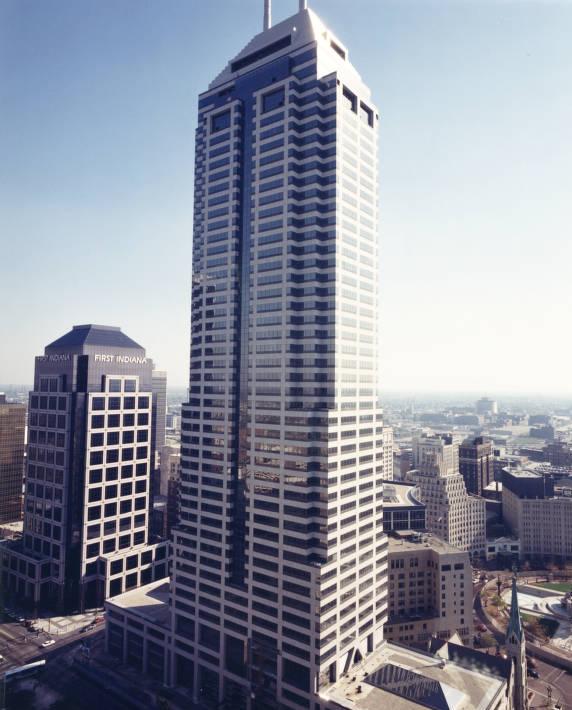, who arrived in Indianapolis from Vermont in 1831, opened a bank in a one-room office at 8 East Washington Street in 1839, with $3,000 of capital. The official name was S. A. Fletcher & Company, but the bank was known for years as Fletcher’s Bank.

A group of prominent Indianapolis businessmen founded the American National Bank in 1901. In 1910, this bank and the Fletcher National Bank, the successor to S. A. Fletcher & Company, merged to become Fletcher American National Bank with , grandson of the founder, as president. A series of business failures forced Fletcher to relinquish control of the bank and resign as president in 1923. The Fletcher American National Bank did not reopen after the federally imposed “bank holiday” in March 1933. It was reorganized under federal trusteeship as the American National Bank.
Alexander Metzger, a German-born baker, went into banking in 1863 as Alexander Metzger & Sons. One of his sons, Albert E. Metzger, was instrumental in the merger of the Marion Trust Company and the German American Trust Company, the successor to the A. Metzger agency, into the Fletcher Savings & Trust Company in 1912.

The president of this new bank was Evans Woollen Sr. His son, Evans Woollen Jr. was president of the Fletcher Trust Company (the name had been shortened in 1931) when it merged with the American National Bank on December 31, 1954. This new entity, the American Fletcher National Bank (AFNB), became the second-largest bank in the state, and Evans Woollen Jr. was named its president.
On July 31, 1959, the Fidelity Bank & Trust Company merged with the American Fletcher National Bank. This created the largest bank in Indiana, which retained the name AFNB. Evans Woollen Jr. died in February 1959. , who acquired control of the Fidelity Bank in 1935 and built it into one of Marion County’s leading banks at the time of the merger, was then named chairman of the AFNB board of directors.
The American Fletcher Corporation (AFC) was established in 1968. It was a one-bank holding company, one of the first of its kind in the country. The holding company would be the means to expand financial services opportunities into banking-related enterprises and to do so in a wider geographical area. When Indiana bankers were allowed to expand beyond their own county borders, AFC was ready.
Under the leadership of , who was named president in 1972 and chairman of the board in 1973, AFC became the largest and most profitable bank holding company in the state. In addition to wanting to have the dominant banking institution in Central Indiana, McKinney had two other goals: the construction of a new bank building and the reformation of Indiana’s archaic banking laws. Both these goals were accomplished but proved to be long and arduous in their attainment.
Banc One Merger
By May 1986, AFC had acquired four banks in the state of Indiana and had two other acquisitions in process. However, nine months before, in late summer 1985, McKinney had begun to think about and analyze the question of interstate merger and acquisition. This led to a study of potential linkage partners within the Midwest. By the process of elimination, Banc One Corporation of Ohio seemed to be the organization that best suited AFC’s requirements.

The merger of American Fletcher Corporation into Banc One Corporation was announced on May 11, 1986. McKinney became chairman and chief executive officer of Bank One, Indiana, with 12 affiliate banks throughout Indiana reporting to him. He remained chairman and CEO of American Fletcher National Bank, which was renamed Bank One, Indianapolis.
McKinney was responsible for creating this concept of a state holding company operating under the main holding company. All of the affiliate banks in Indiana would remain independent operating units, each with its own board of directors responsible to the board of directors of the state holding company, Bank One, Indiana Corporation, which in turn reported to the main holding company, Banc One Corporation. The affiliate banks in Ohio were then organized in like fashion. This model continued to serve well as Banc One Corporation expanded throughout the country. By 1992, Bank One, Indianapolis, which employed approximately 2,500, was the largest bank in the city and state with total assets exceeding $4.78 billion.
In 1998, Banc One merged with NBD Bank of Chicago to form Bank One Corporation. Previously in 1992, NBD had acquired . Thus, the two banks that had been the first-and second-largest banks and major rivals in Indianapolis became part of the same multi-state banking corporation. At the time of the merger, Bank One was the sixth-largest bank in the U.S.
Chase Bank Merger
In January 2004, J. P. Morgan Chase and Company announced that it would purchase Bank One Corporation for $58 billion. It was the third-largest bank deal in U.S. history. The merger, which was solidified in July of that year, created the second largest bank in the United States. The move extended New York City-based Chase’s reach into the Midwest. This led to the transformation of Indianapolis’ Bank One institutions into Chase Bank branches.
The fate of locally-owned, Indianapolis-based banks like American Fletcher followed a national trend. According to the American Business Center, no other industry has seen more name changes and mergers. Of the 50 largest banks that existed in the U.S. in the 1990s, only 10 of them still existed as “independent survivors” by the end of 2020.
FURTHER READING
- Hamlett, Ryan. “A Room with a View – Indiana’s Tallest Building, The Chase Tower.” Historic Indianapolis, March 26, 2013. https://historicindianapolis.com/a-room-with-a-view-indianas-tallest-building-the-chase-tower/.
CITE THIS ENTRY
APA:
Plimpton, T. L. & Opsahl, S. (2021). American Fletcher National Bank. Encyclopedia of Indianapolis. Retrieved Dec 14, 2025, from https://indyencyclopedia.org/american-fletcher-national-bank/.
MLA:
Plimpton, Thomas L. and Sam Opsahl. “American Fletcher National Bank.” Encyclopedia of Indianapolis, 2021, https://indyencyclopedia.org/american-fletcher-national-bank/. Accessed 14 Dec 2025.
Chicago:
Plimpton, Thomas L. and Sam Opsahl. “American Fletcher National Bank.” Encyclopedia of Indianapolis, 2021. Accessed Dec 14, 2025. https://indyencyclopedia.org/american-fletcher-national-bank/.

Help improve this entry
Contribute information, offer corrections, suggest images.
You can also recommend new entries related to this topic.